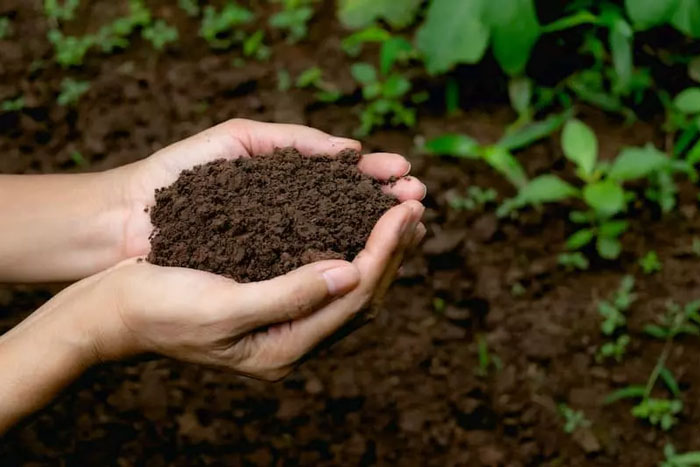Soil is made up of fine and coarse mineral particles. The term soil texture refers to the relative distribution of mineral particles of different sizes (clay, silt, sand).
Sand: They have a size of about 2000 to 5 microns and they are usually made of quartz, feldspar and mica.
Silt: They have a size between sand and clay. Physically and mineralogically, silt is the same as sand, but since it has a smaller size and a higher specific surface area, some clay is always attached to it.
Silt particles in the soil tend to stick to each other or to other particles due to moistening and are effective in the formation of silt
Clay: particles of 2 microns and smaller that are colloidal materials. Clays are in the group of secondary minerals (aluminosilicate). Clays have high physicochemical activity due to their high specific surface area and negative surface charge.
Types of soil texture classes
1- Sand: the minimum amount of sand is 85% and the total and 1.5 times of clay particles is less than 15%.
2- Loamy sand: sand is between 70% and 90%, and the total amount of silt and 1.5 times of clay particles is more than 15% and the amount of clay is less than 30%.
3- Sandy loam: clay is less than 20% or the total % of silt and twice the amount of clay is more than 30%. Soils whose sand content is between 24 and 52%, and whose clay content is less than 7% and silt content is less than 50% are called loamy and sandy soils.
4- Loam: The amount of clay is between 7 and 27%, silt is between 28 and 50%, and sand is less than 52%.
5- Silt loam: The amount of silt is more than 50% and clay is between 12 and 27%, or the amount of silt fluctuates between 50 and 80% and the amount of clay is less than 12%.
6- Silt The amount of silt is less than 80% and the amount of clay is less than 12%.
7- Sandy clay loam: It has 20 to 35% clay and its silt content is less than 28% and its sand content is more than 45%.
8- Clay loam, the amount of clay varies from 27 to 40% and the amount of loam fluctuates from 20% to 45%.
9- Silty clay loam, the amount of clay is 27 to 40% and the amount of sand is less than 20%.
10- Clay and sand (sandy clay), the amount of clay and sand is more than 35 to 45%.
11- Clay and silty clay, the amount of each clay and silt is more than 40% respectively.
12- Clay, the amount of clay is more than 40% and the amount of sand and silt is less than 45 to 40%, respectively.
بافت خاک شن% سیلت% رس% رس 45-0 40-0 100-40 سیلت 20-0 100-80 12-0 شن 100-85 15-0 10-0 لوم 52-23 50-27 27-7 شنی لومی 85-70 30-0 15-0 لومی شنی 85-45 50-0 20-0 لوم رسی شنی 80-43 27-0 35-20 لومی سیلتی 50-0 100-50 27-0 لوم رسی سیلتی 20-0 71-40 40-27 لومی رسی 45-20 52-17 40-27 رسی و شنی 65-45 20-0 55-35 رسی و سیلتی 88-70 30-0 14-10 |
بافت خاک بر قدرت تغذیه کنندگی خاک، نفوذپذیری و نگهداری آب در خاک و نوع کشت اثرگذار است برای نمونه گیاهان غده ای وگیاهانی که ریشه آنها به مصرف می رسد، خاک هایی با درصد شن بالاتر مناسب هستند. معمولا بافت لوم مناسب ترین بافت خاک برای کشاورزی است.
بافت خاک و نفوذپذیری آب در خاک
بافت خاک نفوذ پذیری آب در خاک (میلی متر بر ساعت) شن 1/210 شنی لومی 2/61 لومی شنی 9/25 لوم 2/13 لومی سیلتی 9/6 لوم رسی شنی 3/4 لومی رسی 3/2 لوم رسی سیلتی 5/1 رسی و شنی 3/1 رسی سیلتی 1 رس 5/0 |
بافت خاک و نوع کاشت
بافت خاک نفوذ پذیری آب در خاک (میلی متر بر ساعت) شن ذرت، بادام زمینی، سیب زمینی، پیاز، انگور شنی لومی لومی شنی لوم گندم، جو، ذرت، نیشکر، پرتغال،لیمو، انار لومی سیلتی سیلت لوم رسی شنی برنج، سورگوم، پنبه،چغندر قند، موز، کاهو، کلم لومی رسی لوم رسی سیلتی رسی و شنی رسی سیلتی رس |

بدون دیدگاه